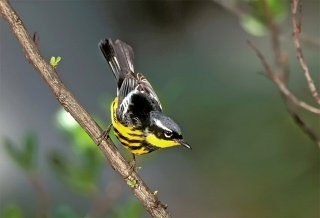|
Trail Guides
|
New Jersey Audubon - Cape May Bird Observatory, Northwood Center
|
1
 
|
701 East Lake Drive, Cape May Point, NJ 08212
Phone: (609) 884-2736
www.njaudubon.org/SectionCapeMayBirdObservatory/CMBOHome.aspx
New Jersey Audubon
Travel South on the Garden State Parkway beyond its terminus onto the bridge into the town of Cape May. You are now on Rt. 109, which becomes CR 633 or Lafayette Street. Follow Lafayette Street for 1.9 miles until it ”doglegs” right onto Sunset Boulevard, CR 606. Follow
Sunset Blvd. approximately two miles and turn
Left onto Lighthouse Avenue. Turn Right onto
Lake Drive after just a few hundred yards. The Center is on your Right. Map
 |
| Magnolia Warbler | Kevin Karlson |
| |
| | Start your visit to the area at New Jersey Audubon Cape May Bird Observatory. The Northwood Center is a small house located in a patch of tall trees adjacent
to Lily Lake. The combination of trees, untouched undergrowth, a small pond, and ample birdbaths and feeders attract birds year-round and especially during the spring and fall migrations. The Center is also a hub for up-to-the-minute information
on unusual birds and natural phenomenon in the region. Gather local maps and brochures on local businesses, and look around the bookstore, which carries a variety of backyard birding necessities and gifts for wildlife lovers.
The staff at Northwood keeps the feeders and the birdbaths in working order throughout
the cold season, supplying wintering songbirds essential food and water. It’s a great time for photographing many of the handsome species
we sometimes take for granted. Also, check Lily Lake for waterfowl and gulls.
Northwood Center’s wooded lot offers migrating songbirds a perfect resting spot.
Look for warblers, tanagers and orioles around the grounds, and scan Lily Lake for swifts
and swallows.
It’s family time, for the birds, that is,
as adults frequent the feeders and feed their young. In addition, the wildlife garden has been planted with both host plants and nectar plants to attract butterflies.
Northwood is a hub of activity in the fall,
as wildlife watchers stop in to record their
sightings, and find out what others have seen. There’s always the possibility of an unusual migrant thanks to the Center’s wildlife habitat.
Follow the path around the house and into the habitat garden for close looks at native plants, many of which are labeled, and the potential for a close up view of a migrating warbler or a resident wren.
|
|
|